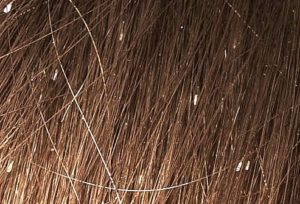https://schoolipm.tamu.edu/2019/10/25/spn-head-lice-a-lingering-pest/
Feel free to pass this one along to parents, teachers, after school programs, anyone who has questions about head lice. |
Posted: 25 Oct 2019 08:24 AM PDT
As October comes to end and the
weather changes over from warm to cold, kids will start carrying more garments.
Cooler weather is prime time for head lice outbreaks. Contrary to popular
belief, head lice are not a sign of poor hygiene; in fact, lice are perfectly
comfortable on a clean head. According to the Centers for Disease Control
(CDC), there is no reliable data on how many people get head lice each year in
the United States; however, an estimated 6 million to 12 million infestations
occur each year in the United States among children 3 to 11 years of age.

Nits adhere to the
hair and can become dislodged when kids share items like headphones, hair
brushes, helmets and other items.
Lice eggs, known as “nits,” are firmly
adhered onto hair shafts, making it especially difficult to remove them. Each
louse can live up to one month and produce one hundred offspring with regular
meals of human blood. Head lice can be transferred by head-to-head contact,
sharing hats, combs and pillows.
Screening for head lice in schools is
a very useful role for the school health professional. Active infestations need
to be addressed individually. Parents of all children using the room with any
child with confirmed head lice should be notified and provided with basic
information including description, signs and symptoms; strategies to eliminate
head lice. The information should include where to go for additional help.
School districts vary in adoption and
enforcement of the controversial “No Nits” policy, which states that any
student with head lice, even a single nit, should be forced to stay home from
school. The American Academy of Pediatrics
and the National Association of School
Nurses advocate that “No Nit” policies should be discontinued.
Since lice do not spread disease or have any harmful effect other than an itchy
scalp, requiring students to miss school is unnecessary and detrimental to
their performance. The presence of nits alone is not a good predictor of
infestations; only about 18% of children with nits alone will become infested
with adult lice. Supporters of the zero tolerance policy, including the National Pediculosis Association,
state that the only way to control and stop the cycle of lice infestation is to
keep kids out of school until all nits are removed.
How to Spot Head Lice
Lice have three pairs of legs and are
grayish-white in color. Nits are oval white cylinders that are about a
sixteenth of an inch long. Lice prefer to lay their eggs near the ears and the
back of the head.
Prevention and Treatment
Children should be encouraged not to
share combs, hats or other personal belongings. Once an infestation is
detected, non-chemical treatment options include washing clothing, pillow
cases, sheets, blankets and other bedding material in hot soapy water and
drying on a high heat cycle to kill all lice and their eggs. Use of lice sprays
on furniture and toys is not effective. Non-washable items can be sealed in
plastic bags for seven to ten days.
Manual removal of nits close to the
head is always recommended. Fine-toothed “nit combs” are helpful. Combing and
brushing wet hair damages lice and eggs significantly. Additionally, use of a
hair dryer further injures adults, nymphs and nits. Botanical-based lice
removal aids such as Lice-B-Gone® and De-Licer® may ease removal. See our
IPM Action Plan
for more tips.
To remove lice and nits,
1. Comb and divide hair into sections,
use a metal fine toothed louse comb to remove nits and lice. After combing each
section dip the comb in a container of hot soapy water to remove lice and nits.
2. Repeat if nits are still attached within 1 cm of the scalp.
3. Repeat until all the sections of hair have been systematically combed.
4. Clean nit removal comb, clips, brushes, headphones, hats, etc. with hot soapy water.
2. Repeat if nits are still attached within 1 cm of the scalp.
3. Repeat until all the sections of hair have been systematically combed.
4. Clean nit removal comb, clips, brushes, headphones, hats, etc. with hot soapy water.
For more information about head lice,
download the Human Lice factsheet or visit the Texas Department of State Health
Services website Managing Head Lice in School Settings and at
Home Head Lice (Pediculosis) Fact Sheets
No comments:
Post a Comment